
Citation: Wei Meng, et al. Systematic Review of Chinese Medicine for Ovarian Endometriosis. Int J Pharmacogn Chinese Med 2017, 1(3): 000116.
*Corresponding author: Wei Meng, School of Chinese Medicine, The University of Hong Kong, Pokfulam, Hong Kong, Tel: +852 39170483, Email: bmeng@hku.hk
Background: Ovarian endometriosis is a common disease found in women of childbearing age. Existing therapies in western medicine have limitations in various aspects including management of pain, prevention of recurrence and promotion of fertility. Numerous Chinese medicine preparations have been shown to possess therapeutic potential in relieving EMS symptoms and shrinking the OEMS without significant adverse effects, although the clinical efficacy needs to be further confirmed with large amounts of well-designed experiments.
Objectives and Methods: RCTs of Chinese medicine concerning ovarian endometriosis are included to work out this systematic review in order to provide scientific evidence for its efficacy and safety.
Results: 16 articles were selected out of 427 literatures for a systematic reviews and a meta-analysis was conducted. The studies suggest that the ovarian endometriosis patients’ recurrence rate is lower and the pregnancy rate is higher in the Chinese medicine group, while the total effective rate, change in the size of endometrial cyst and CA125 level in both Chinese and Western medicine groups shows no statistical significance. Although the result favored the Chinese medicine group for lower dysmenorrhea rate and less adverse effects, the size of sample data and high heterogeneity between studies adversely affected the reliability of the results.
Conclusion: Chinese medicine has two advantages over Western medicine in treating ovarian endometriosis, which are the low recurrence rate and high pregnancy rate. However, due to the limited number of literatures available and variations in their experimental methods and outcome measures, the conclusive results remain elusive. Larger scales of randomized controlled trials and more scientific evidence are needed to prove the efficacy and safety of Chinese medicines for ovarian endometriosis.
Keywords: Ovarian endometriosis; Chocolate cyst; Traditional Chinese medicine; Randomized controlled trial; Systematic review
Ovarian endometriosis (OEM) is a hormonedependent disease characterized by the unusual growth of endometrial tissue inside the ovaries. It behaves in malignant manner, for example, endometriosis can be distantly metastatic, invasive, and rapidly recurring. A French epidemiological study released in 2016 shows that, endometriosis patients account for 1.5% of 14,239,197 hospitalized women at childbearing age [1]. The increasing incidence rate of endometriosis, due to early menarche, late menopause and advanced maternal age, contribute to the burden of ill health in women [2]. According to The American Congress of Obstetricians and Gynecologists (ACOG), 54.9% endometriotic growth occurs at the ovary, the most common site of endometrial implantation [3]. Approximately 80% OEM are unilateral ovarian endometriosis, while around 50% of them involve both ovaries [3-5]. Although surgical approaches have been recommended as a definitive management of OEM, surgical treatment is an invasive procedure and causes tissue injury. Pharmacological therapies are effective in reducing the size of OEM and relieving symptoms. However, rapid recurrence and broad adverse side effects have largely limited the use of pharmacotherapy. A search for alternative treatment strategies is therefore needed. Numerous Chinese medicine preparations have been shown to possess therapeutic potential in relieving OEM symptoms and shrinking the OEM size without significant adverse effects, although the clinical efficacy needs to be further confirmed. On the basis of empirical evidence and clinical practice, randomized controlled trials (RCTs) of Chinese medicine concerning ovarian endometriosis are located to conduct a systematic review for assessing its efficacy and safety.
Materials and MethodsWe searched for published RCTs of Chinese Medicine for ovarian endometriosis with the English keywords “Traditional Chinese medicine, Chinese medicine, Chinese herbal medicine, Herbal medicine, ovarian endometriosis, Chocolate cyst” and Chinese keywords “中醫,中藥,卵巢子宮內膜異位症,巧克力囊腫”. Searching strategy used was presented in the figure below (Figure 1). The following databases were searched: MEDLINE (from 1950 to Jan 2016); PubMed (from 1927 to Jan 2016); Wan Fang Database (Chinese Ministry of Science and Technology) (from 1980 to Jan 2016); and China National Knowledge Infrastructure (CNKI) (from 1915 to Jan 2016).We also screened bibliographies of the selected articles and searched manually for any internet inaccessible articles. The language of the articles was limited to English and Chinese. Publications without full text were excluded.
Systematic ReviewData Extraction and Quantitative Analysis: 16 articles were selected out of 427 literatures and the exclusion criteria were presented in the PRISMA flow diagram below (Figure 2). Extraction forms were designed for data extraction from the selected publications quantitatively.
Meta-analysisData Synthesis: We carried out the statistical analysis using RevMan5.3. Quantitative data was analyzed by standard mean differences (SMD), while categorical variables were analyzed with using odds ratio (OR) and relative risk (RR). If substantial statistical heterogeneity (P<0.05) were detected, random effects model (RE) would be selected, otherwise, fixed model (FE) would be used for homogeneity (P>0.05). Results were presented in forest plot with its 95% confidence interval. Funnel plot would be used in presenting potential publication bias if necessary. Characteristics of the included studies and also their risk of bias were presented as follow (Tables 1 & 2).
Results and Discussion16 clinical literatures were selected according to the inclusion and exclusion criteria, in which, 1619 cases were included. One of the selected clinical literatures included 3 groups, which can be seen as two randomized controlled trials. Hence, 17 randomized controlled trials were included in this study.
Chinese Medicine for Ovarian EndometriosisTherapeutic Principles: Chinese medicine treats the human body as a whole system. Its therapeutic principle aims at resolving the causes of the disease and helps body in restoring internal dynamic balance, hence, relieving the symptoms. Amongst all the selected RCTs, “invigorating blood circulation” (78.57%) and “eliminating blood-stasis” (64.29%) were the most common therapeutic principle applied (Table 3). Less common ones included “resolving masses and swelling” (50.00%), “regulating the flow of vital energy/ dispersing the depressed liver-energy” (50.00%) and “tonifying the kidney” (35.71%).
Individual Chinese Medicines:s Amongst all the individual Chinese medicine studied for ovarian endometriosis (Table 4), Blue Turmeric Rhizome was the most frequently used individual Chinese medicine (62.5%). The top 10 most commonly used single Chinese medicines included Blue Turmeric Rhizome, Common Burreed Tuber, Yanhusuo Tuber, Red Paeoniae Trichocarpae, Dan-shen Root, Liquorice Root, Nutgrass Galingale Rhizome, Mongolian Milkvetch Root/ Membranous Milkvetch Root, Chinese Angelica, and Chinese Thorawax Root in descending order. The frequently used herbs in the clinical trials were recorded and listed below.
EffectivenessThe meta-analysis in limited randomized clinical trials suggested that the ovarian endometriosis patients recurrence rate is lower and the pregnancy rate is higher in the Chinese medicine group, while the total effective rate, change in the size of endometrial cyst and CA125 level in both Chinese and Western medicine groups shows no statistical significance. As shown in Figures 3 & 4, both the 6-month recurrence rate [FE: 0.38, 95% CI, 0.20-0.72, P=0.003 (P<0.05)] and the 12-month recurrence rate [FE: 0.30, 95% CI, 0.13-0.72, P=0.007 (P<0.05)] of ovarian endometriosis in Chinese medicine group (Chinese Med) is lower than that in Western medicine group (Western Med). Although the 36-month recurrence rate in Chinese medicine group is also lower than that in Western medicine group [RE: 0.44, 95% CI, 0.10-2.73, P=0.44] (Figure 5), the meta-analysis with only 2 randomized clinical trials provides limited support.
As shown in (Figure 6),the pregnancy rate in Chinese medicine group is higher than that in Western medicine group [FE: 2.32, 95% CI, 1.15-4.67, P=0.02 (P<0.05)].Although the result favored Chinese medicines for lower dysmenorrhea rate and less adverse effect, the lack of sample data and high heterogeneity adversely affected the reliability of the result.
Implications for further studies on the use of Chinese medicine in treating ovarian endometriosisThis study suggests that Chinese medicine is more effective than Western medicine in treating ovarian endometriosis: the recurrence rate is lower and pregnancy chances are higher, while the occurrence of dysmenorrhea and other associated symptoms are lower. However, the clinical efficacy of Chinese medicine for ovarian endometriosis needs to be further confirmed with large amounts of well-designed experiments. Moreover, it is difficult to carry out blinded trials between Chinese and Western Medicine since:
Future clinical Chinese Medicine studies should improve in the following:
In conclusion, Chinese medicine is more effective than Western medicine in treating ovarian endometriosis: the recurrence rate is lower and pregnancy chances are higher; while the effect of decreasing the size of endometriosis cyst is similar, while the chances of preventing reoccurrence of cyst and increasing the chances of pregnancy are higher. As pregnancy is the best method to curing endometriosis, the Chinese medicine treatment creates a positive cycle of enhancing the chances of pregnancy and curing the disease. There is medical and exploratory scientific research value in using Chinese medicine as a treatment method for ovarian endometriosis. There is need for future Chinese medicine clinical trials to be conducted based on an international standard, with bigger sample sizes, higher methodological quality, and be in accordance with Chinese medicine diagnostic and treatment theory. The future need to study and practice for the evaluation of Chinese medicine system, but also the direction of our efforts.
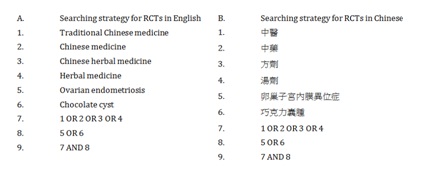
Figure 1: Searching strategy for English and Chinese RCTs
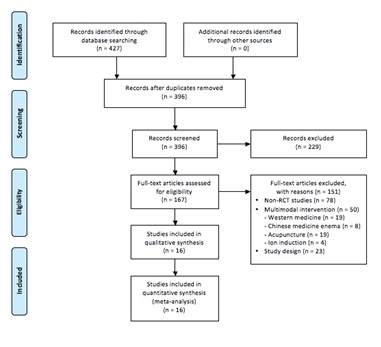
Figure 2: PRISMA Flow Diagram: Study inclusions and exclusions for systematic review.
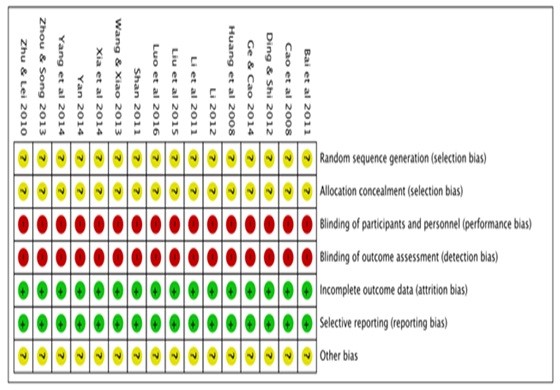
Figure 3: 6-Month recurrence rate of ovarian endometriosis.
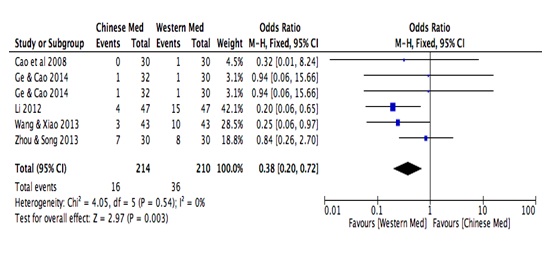
Figure 4: 12-Month recurrence rate of ovarian endometriosis.
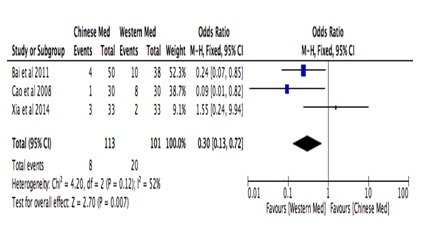
Figure 5: 36-Month recurrence rate of ovarian endometriosis.
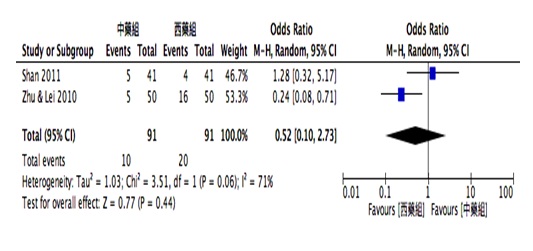
Figure 6: Pregnancy rate of ovarian endometriosis patients.
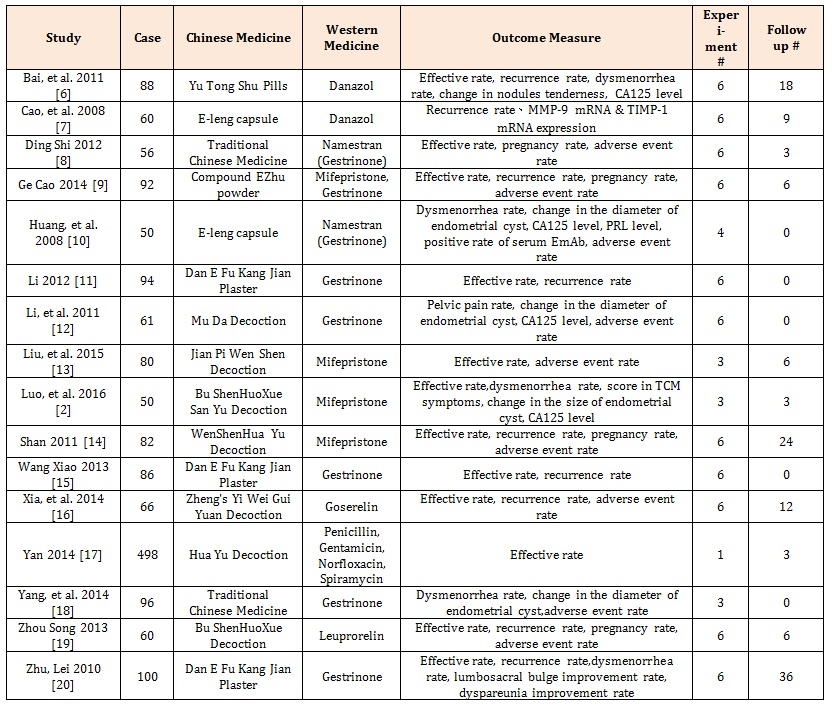
# Experiment and follow up duration measured in month(s).
Table 1: Characteristics of the included studies [2,6-19].

Table 2: Risk of bias of the included studies.
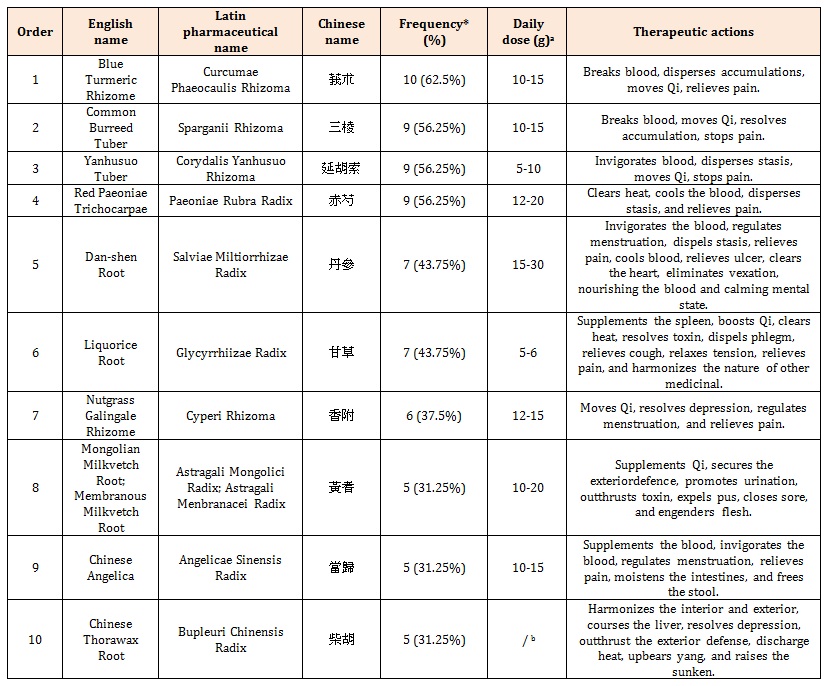
% is the number of RCT using each therapeutic principle/ the number of included clinical trials× 100.
Table 3: Therapeutic principles application of Chinese medicines for ovarian endometriosis.
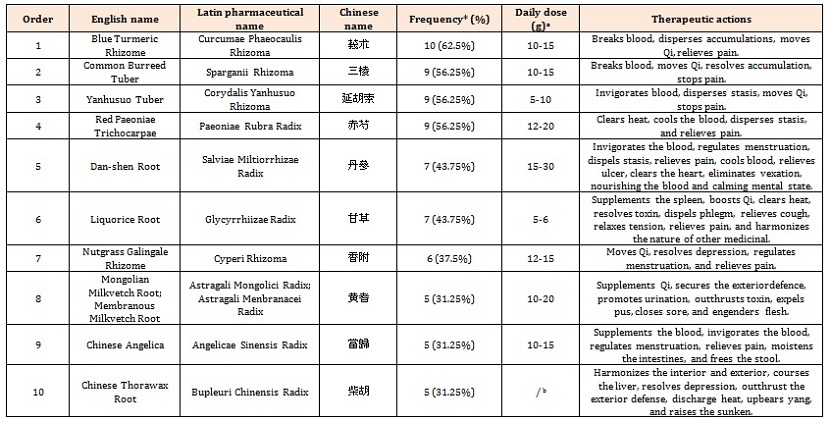
% is the number of RCT using each individual Chinese medicine/ the number of included clinical trials × 100.
Daily dose is the range of the reported daily dose in all included clinical trials.
Not provided
Table 4: Top 10 of most commonly used individual Chinese medicines for ovarian endometriosis.
Chat with us on WhatsApp